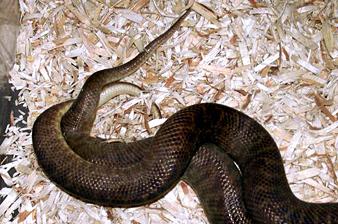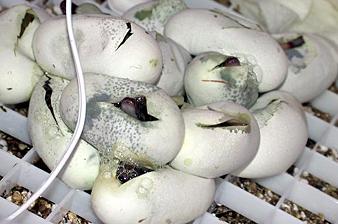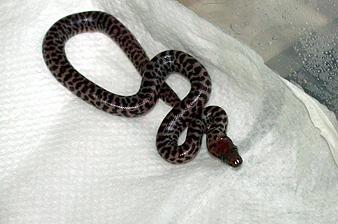Childrens Python Breeding
by Matt & Nicci Turner
Despite confusion over its name, the small and easily kept Antaresia childreni is a snake for all.
We think that most biologists, ecologists, paleontologists and other scientists have daydreamed at one point or another of having the honor of being immortalized with the assignment of their surname to describe an organism to science. What a great thing it would be to be among the scientists who have plants and animals named after them -- the D'Albert's python, the Bibron gecko, the Colett's black snake and others. But to what benefit would that honor be to the understanding of the plant or animal? It is neither descriptive nor geographic, and as is the case for Antaresia childreni, often confusing or misleading.
Childrens Python: A Problematic Honor
In naming new species, it was once common to recognize an individual who acted as a mentor or who has had a profound impact to the scientific development and maturation of the person giving the official description. Unfortunately, this great honor is usually only apparent to a small percentage of the population who study the newly named organism, and it means little to the common observer. Such is the case with the Childrens Python (A.childreni).
 At first glance, the name can have several meanings. This could be a small python, equating the word "Children's" to small like a child. This could be a python suited for children and one that is often owned as a pet by kids, as evidenced by the apostrophe "s." Or perhaps this is a large and dangerous python rumored to feed upon ill-mannered children of north-central Australia. Indeed, not many people associate the word "Children's" with the English chemist, mineralogist and zoologist J.G.Children, who was the keeper of the zoological collection of the British Museum from 1822 to 1840. Children's successor, John Gray, described the Children's python in 1842 based on a preserved, non-cataloged specimen in the museum's holdings.
At first glance, the name can have several meanings. This could be a small python, equating the word "Children's" to small like a child. This could be a python suited for children and one that is often owned as a pet by kids, as evidenced by the apostrophe "s." Or perhaps this is a large and dangerous python rumored to feed upon ill-mannered children of north-central Australia. Indeed, not many people associate the word "Children's" with the English chemist, mineralogist and zoologist J.G.Children, who was the keeper of the zoological collection of the British Museum from 1822 to 1840. Children's successor, John Gray, described the Children's python in 1842 based on a preserved, non-cataloged specimen in the museum's holdings.
Childrens Python: A Natural History
The Childrens python is a member of the genus Antaresia, which it shares the closely related spotted (A. maculosa), large blotched (A. stimsoni) and pygmy (A. perthensis) pythons. Members of this genus are characterized as being of small stature and thin-skinned with earthy coloration and a blotched or spotted pattern. Prior to 1985, all of these species were thought to be forms of the same species and not recognized as distinct. This renders pre-1985 data on childreni essentially useless because it isn't clear which species was actually being studied.
At least one of the preliminary assumption about the Childrens python can be viewed as accurate. It is certainly one of the world's smallest pythons. The adult Childrens pythons on our cage average about 30 inches in length, with one very large female growing to 38 inches. Females are generally larger than males in terms of both length and weight.
These are subtly attractive pythons. While they lack the loud, boisterous colors and patterns of many other species, Childrens python have a quiet beauty. They possess thin, silky skin that reflects a beautiful purplish iridescence in the right lighting. Their eyes are copper to gold with a well-defined pupil. The head is distinctly python in shape with pitted, labial scales around the mouth and the large plate-like scales adorning the top of the head. Adult coloration and pattern varies with the origins of the original bloodline founder animals. All Children python can be colored in earthy tones of brown, tan, rust, and terra cotta. Depending on locality, some retain significant amounts of blotching, and others become nearly patternless with age and maturity. Hatchlings are often boldly patterned with many fragmented blotches of a darker brown or bronze over a pale base color. As soon as they begin feeding and growing, this color pattern begins to fade and the contrast between the blotches and base color begins to decrease.
Children python can be s are found across the north-central portion of Australia, from about the 22nd parallel to the Timor Sea and among several offshore islands. They are found in a variety of habitats ranging from the dry interior to the humid coast, but they are most often found along water-ways within these areas. their preferred micro-habitat seems to be rocky hillsides, outcrops and cave systems, where they hunt other small reptiles and amphibians. Interestingly, The children python is often found in caves, adopting a semi-arboreal lifestyle along the crags and crevices for hunting the many species of small bats in the area.
Childrens Python In Captivity
Captive Children python can make great captives as pets or for study. They are undemanding and low maintenance. They are easily housed and fed because of their diminutive size. They generally have a calm disposition and are easily bred, making them terrific subjects for research too. Fort the last 15, years or so, an abundance of these fascinating small pythons have been available to herpetoculturists, which has also made them quite affordable for most budgets.
Housing childreni can be very basic. They don't require a lot of special treatment to do well. Our adults are housed simply in 32-quart tubs measuring approximately 23 inches long by 16 inches tall. These tubs are contained in a rack system that allows us to eliminate the need for lids. The racks have a section of heat tape at the back of each level providing an 88 to 90 degrees Fahrenheit hot spot on the back floor of the cage. For a substrate, we use shredded aspen bedding at a depth of about 2 inches. We provide a hidebox in the rear of the tub and a water bowl on the cooler end. (Excess humidity should be avoided; humidity needs are naturally met with this setup.) It's that easy. Children python thrive in this simple setup.
If you are more interested in naturalistic vivaria, Children python can be the perfect vivarium occupants. Pythons are often simply too large to be efficiently housed in a showcase-type setup. A pair of adult childreni will do great in a display cage of approximately 48 inches long by 18 inches deep by 24 inches tall. Let your imagination run wild with this setting up a naturalistic cage for this small python. They are at home in a variety of habitats, so sub-desert, woodland and rocky outcrop themes all apply. They will utilize rocky cliffs and large branches, so make sure to stabilize these to prevent them from falling and harming your snakes. Captive Children's are perfectly content to live on mice and small rats. Hatchlings should start on the smallest of pinky mice and quickly graduate through the sizes. Our adults are offered full-grown mice or a couple of rat pups each week. Adult childreni in our care have also readily accepted small chicks.
Making Children Python
 The Children's python is one of the easiest pythons to breed in captivity. Feeding should be halted around November 1 to allow them to clean out their gastrointestinal tracts in preparation for their winter cycling. On November 15, we begin to lower the nightime cage temperature weekly, and reduce the ambient light levels and the number of hours the hot spots are on. By the end of November, nightime temps should be down to 68 to 72 degrees, with the daytime temps in the upper 70s. We provide a daytime hot spot of 86 to 88 for about six to eight hours, but it will probably not be utilized much, if at all.
The Children's python is one of the easiest pythons to breed in captivity. Feeding should be halted around November 1 to allow them to clean out their gastrointestinal tracts in preparation for their winter cycling. On November 15, we begin to lower the nightime cage temperature weekly, and reduce the ambient light levels and the number of hours the hot spots are on. By the end of November, nightime temps should be down to 68 to 72 degrees, with the daytime temps in the upper 70s. We provide a daytime hot spot of 86 to 88 for about six to eight hours, but it will probably not be utilized much, if at all.
Over Thanksgiving weekend, the pythons are paired up, and the breeding season officially begins. Copulations most often occur at night and are frequent. It is not uncommon to observe breeding activity almost every night for the next couple of months. Breeding activity seems to taper of during the coolest periods from around New Year's Day to February 1. Renewed interest occurs in mid-February as the temperatures begin to return to the usual summer levels.
Ovulation occurs around the lower third of the female's body, and is often witnessed in mid-March through mid-April. Relative to the snake's size, the ovulation swelling can seem huge. At this time, the animals are separated, and feeding soon resumes for the males.
 After ovulation, the females soon begin a shed cycle. This shed will seem prolonged and typically lasts five to seven days longer than a normal shed. Once the shed completes, expect eggs in about 28 to 30 days.
After ovulation, the females soon begin a shed cycle. This shed will seem prolonged and typically lasts five to seven days longer than a normal shed. Once the shed completes, expect eggs in about 28 to 30 days.
The female should be given a secure nestbox in which to deposit her clutch. A small cat litter pan or large butter tub filled with moist sphagnum moss can be used successfully. The average clutch size for us is about a dozen eggs, but other breeders have reported as many as 20 in a clutch. We recommend moving the eggs to an incubator after they are laid to allow the female to regain lost weight for the next breeding season.
If the female is not scheduled to breed again the following year, we recommend trying maternal incubation. This is an intriguing part of python life that is frequently forgotten about in captivity. Female childreni make excellent mothers, and it is most rewarding to see them so what comes naturally. This also allows hobbyists to gain a lot of insight into the incubation process of pythons by taking temperature, humidity and observational notes. Trust me, your findings will lead to more questions, more hypotheses and more knowledge of what happens during python egg incubation.
If artificially incubated, the eggs should only be set up on slightly damp vermiculite. These small eggs have a tendency to absorb too much water and weep yolk if exposed to overly damp conditions. A good vermiculite-to-water ratio is 2-1 for these eggs. At an incubation temperature of 88 to 89 degrees, the eggs should hatch in about 55 days.
Childrens Python: Neonate Care
 Hatchling Children's are very tiny snakes, and some extra precautions should be mentioned when setting up the hatchlings. First of all, their small girth should be noted when housing them in rack systems. They can easily squeeze through the tiniest gap, and this makes keeping them in a lidless rack system difficult.
Hatchling Children's are very tiny snakes, and some extra precautions should be mentioned when setting up the hatchlings. First of all, their small girth should be noted when housing them in rack systems. They can easily squeeze through the tiniest gap, and this makes keeping them in a lidless rack system difficult.
We found what works best is tp house them individually in 6 1/4 inch-diameter deli cups. The cups can be punched around the rim with tiny ventilation holes for air exchange. They can be the placed on a thermostat-controlled strip of 3-inch heat tape to provide a hot spot. Make sure only a third or so of the cup is directly on the tape to prevent overheating. A 2-ounce soufflé cup makes a great water bowl, and a folded piece of newspaper on top the aspen creates a sufficient hide.
Feeding new hatchlings can also be tough because of their small size. We generally offer food about three weeks once they shed and fully digest their yolk. No more than a day-old pinky mouse can be offered. Fortunately, this size is easy to come by if you breed your own mice, and most frozen rodent distributors will fill orders for one-day-old pinkies.
 Most of our hatchlings have started feeding on live newborn mice, but a few need some assistance. There is a percentage of each clutch that holds out for foods that smell more like their natural prey, and lizard scenting becomes necessary. Anoles work well for this, as does the shed skin of skinks and geckos. Sometimes one or two babies in a clutch will be extra rebellious and require a few assist feedings. We use pieces of mouse tail for this. Just break the tail off of a frozen rodent, let it thaw and cut it into 1-inch sections. Insert the piece into the snake's mouth, and most often the baby will do the rest. This is not very nutritious, but it provides a good calcium boost and has saved many baby snakes for us over the years.
Most of our hatchlings have started feeding on live newborn mice, but a few need some assistance. There is a percentage of each clutch that holds out for foods that smell more like their natural prey, and lizard scenting becomes necessary. Anoles work well for this, as does the shed skin of skinks and geckos. Sometimes one or two babies in a clutch will be extra rebellious and require a few assist feedings. We use pieces of mouse tail for this. Just break the tail off of a frozen rodent, let it thaw and cut it into 1-inch sections. Insert the piece into the snake's mouth, and most often the baby will do the rest. This is not very nutritious, but it provides a good calcium boost and has saved many baby snakes for us over the years.
Final Thoughts on Childrens Python
The Children python is a great small species to keep. These pythons are undemanding in care and easy to breed. These factors make them terrific study subjects as well as pets. They also offer great change of pace for breeders working with larger snakes and provide a back-to-basics project for even the most seasoned herpers.
We believe that true herpetoculturists can find interest and fascination with any reptile, whether they are "money makers" or not. While Childrens python is considered investment animals, they are great, easy-to-care-for snakes that deserve recognition.



